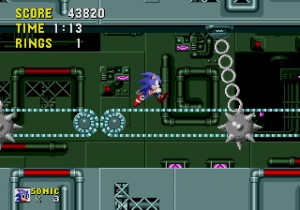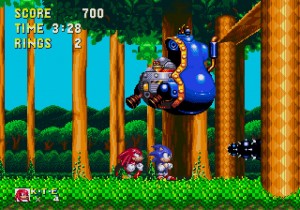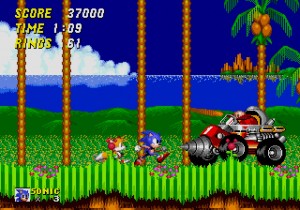Aliens: Infestation

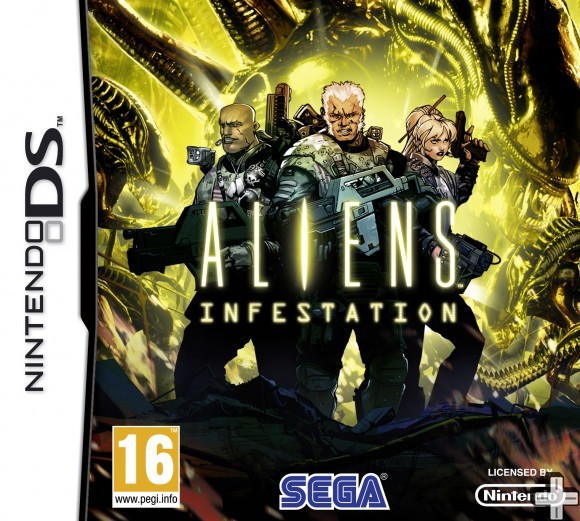
Space, the final frontier. These aren’t really voyages of the Starship Enterprise, because if they were Aliens: Infestation on the Nintendo DS would be a search for diplomacy. Instead, what SEGA present to us is the stereotypical Jarhead marine type that Hollywood convince us will populate the future on other planets. Throw in some big guns, hungry aliens and explosions to rival a nuclear blast and we have Aliens: Infestation.
In the latest title of what have become a huge franchise of movies, comics and video games, Aliens: Infestation expands on the universe which has one major peril – the Xenomorphs. Set after the events of the second film – Aliens, a tactical team made up of 4 marines set off on a mission to rescue survivors from the planet LV-426 and the spaceship U.S.S Sulaco . As always, things are not what they seem and a certain company named Wayland- Yutani crops up time and again. The team must battle through a bounty of Facehuggers, Xenomorphs and the occasional Alien Queen to uncover the truth and more importantly, save their own skins.
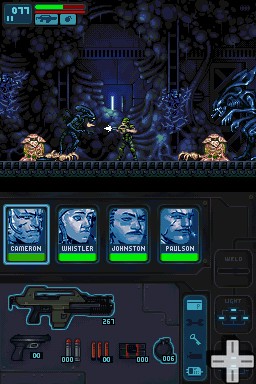
Cleverly the developers, WayForward have introduced the notion of if a marine is killed, they are dead. No respawns, no extra chances. Gone forever. This may seem an impossible task with only four marines and 1000s of creepy-crawlies on the loose, but there are solutions. Through out the game additional Marines will be stumbled across who will join the team – provided there is space. Each has their own different actions, speech and style and mixes the game up well. Just don’t get too close as they probably will end up splattered across the scenery.
To prevent the spreading of Marines like icing on a cupcake come the weapons. At the start of the game there are two: the ever familiar automatic rifle and pistol. As progression is made, weapons such as the ever fun flamethrower become available. A bounty of ammunition litters the levels so running out is never on the cards. The environments in Aliens: Infestation are presented in a 2D side scrolling style looking like it came straight from the SNES era.
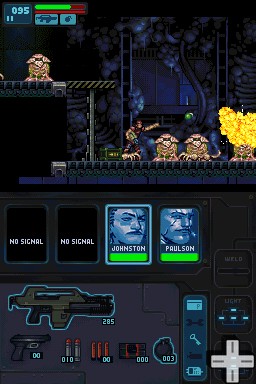
Character sprites work beautifully in this packaging and there is nothing more satisfying than seeing on of the pesky aliens explode into a heap of green blood and body bits. Along with the sprites, each Marine has the same artistic look when speaking as the comic books. This keeps the overall look of the franchise constant and doesn’t alienate fans of the series. The Aliens themselves look as good as ever as do the explosion animations that destroy them.
The enemy does respawn at an alarming rate, and even if the room is large enough then some times if you have made it to one end of a room a big alien will be waiting to feast on a few body parts. This factor brings a level of frustration to the game as a lot of backtracking is needed to make any progress. There is a lot to explore in any one level, however the chances of finding anything except ammo and health are low as there are no extra items to be found save for the extra Marines.
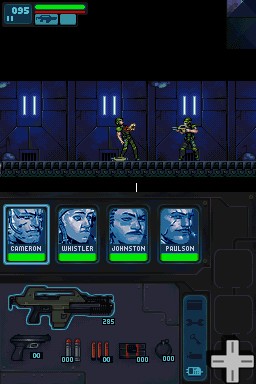
Marines do have more than just a big gun at their disposal, the ability to run and out manoeuvre the Alien scourge has been added to make sure ammo is conserved and those who want to make progress can do with ease. When shooting the controls become unresponsive which does get annoying since the Aliens will use the walls and climb over the Marine. So unless extreme firepower is used the Xenomorph will land at least one bite before it is disposed of. Adding to the difficulty of the game comes the Facehugger. It is small to hit, but if it does come into contact with a Marine, then it is almost game over.
Thankfully, the difficulty is one of only a couple niggles with Aliens: Infestation. The other is lifespan of the game. It is far too short for what could have been a mammoth exploration of a starship and an entire planet. The game will last a maximum of 10 hours. That is if the Marines drop quickly. This could have easily been solved with the addition of collectables or even a multiplayer co-op so people could create their own team of soldiers to fight.
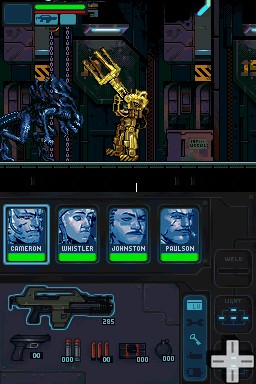
Aliens: Infestation is a difficult game to play through with hard enemies and a few that can kill with one hit. However the struggle does not last long enough, it could have done with more expansion on some levels to make it more involving. On a long commute to the office this game will make time go quickly, as what SEGA and WayForward have created a decent 2D action/shooting exploration game. While the game may lack depth, it has the style and design of an Aliens title that adds to it’s charm.
Sonic Classic Collection

Sonic.
The very name causes us who are in their late teens and older to smile, that sad smile that you only pull when you’re happy but sad at the same time. The juxtaposition in feeling that causes internal conflict and to remember everything with a shade of rosé. To anyone who’s not old enough to have played games between 1991-1999 will simply laugh. Sonic has managed to loose it’s classic and perfect status that it had back in the early days of what could be considered modern gaming, with some truly hideous titles that’s left nothing but a sour taste in the players mouth.
In an attempt to pacify the concerns of the players and so that Sega know that they’ve still got a cash-cow, the developers over at the Sonic Team are doing what’s been demanded of them for a long time: 2D Sonic games. Of course, just making a game in 2D doesn’t mean it’s going to be a good, just look at Four Swords Adventures from the Zelda series to see that. Yet Sonic the Hedgehog 4 Part 1 looks like it’s going to be great and of course the marketing department over at Sega can’t miss the chance to make a bit of cash from this old, arthritic hedgehog.
Welcome: Sonic Classic Collection, on the Nintendo DS. Featuring all of the main Sonic games that came out on the Sega Mega Drive, with the exception of the Spinball and 3D games. Of course, the majority of these games have been re-released dozens of times over the years, heck; I even own all of the main Sonic titles two or three times in different forms as it is. What makes the Sonic Classic Collection different from all of the previous editions of these games is simple – Knuckles.
In the majority of the older editions Sonic and Knuckles was added on at the end as a sidethought, that last truly Sonic 2D game before the Sega Saturn came out with all of its new thoughts, music and Sonic CD. It’s that game that a lot of people forget about – just like Paper Mairo 64. This time around though, Sega have put a lot of effort into making sure that Knuckles is recognised and that their hardwork has not gone amiss – Knuckles can appear in Sonic 2 and Sonic 3 as himself. It’s time to actually sit back and pretend that you’ve pulled that Mega Drive out of the TV unit and put Sonic 2 on top of Sonic and Knuckles and hope the cat or dog won’t run over the Mega Drive causing this precariously placed object to fall apart.
The one downfall with Sega’s attempt at DS lock-on technology is that they’ve left out one key game – Sonic 1. Sonic 1 never actually featured Knuckles in the game; however, if I were to place Sonic 1 into Sonic and Knuckles I’d be met with a memorable screen of Robotnik, or as he’s now known Eggman, telling me off. However, if I was persistent I’d be met with the random Sphere World that was playable in Sonic 3 when I’d gathered enough rings or had jumped through those Giant Rings. This is sadly missing from Sonic Classic Collection as it can and did provide hours of pointless entertainment with nothing to show how well you’ve done, except for a strange sense of achievement.
Of course, if this was the title’s only let down it would be easily permissible; unfortunately, it’s not. The first thing that any keen Sonic player will notice is that the music is different, not changed, but different. This is due to the version of the original titles Sonic Classic Collection is using, it’s the US version. The NTSC version of all four games was faster than what we had in the UK, so it sounds odd and although it’s slightly off putting at first, it’s something that I could learn to live with. It just meant that some of my favourite Sonic tunes had gone to bad club and had an amateurish DJ just up the tempo on them.
When playing the various games, initially there seems to be very little change, which is the way it should be. These games are direct ports from the original games and as such, they retain all of the original charm, design quirks and simplicity that made them instant classics in the first place. Sonic 1, although twenty years old next year, has retained all of the glamour of the age and is as playable in one sitting today as it was in the days before saving. Sonic 2, the sequel and better of Sonic 1 has managed to keep it’s momentum going, even thought the levels have been played to death and all of the secrets are known to all. Sonic 3, the youngest brother who just isn’t as good as his older brothers shines the most out of this remake as it features the Save function it’s older brothers don’t and it also manages to recapture the Sonic magic that the first two had in abundance that’s been sorely lacking in recent years. Sonic and Knuckles the forgotten cousin once removed plays brilliantly and is as challenging and as amusing as it was the first time around.
The issue with all of these games, including the lock-on titles is the actual port from Mega Drive to DS. There is significant slow down and it’s not something that’s only spotted thirty minutes into the game either, as soon as I booted up Sonic 1 and ran and jumped to get the 10 Rings box on the ledge the slow down started, although subtle and slight it was noticed immediately. Whilst contuing to run around the various levels in Sonic 1 the slow down becomes more noticeable, it’s bareable but noticeable. Certainly nothing like the slow down that’s featured when I used to play 2 player mode in Sonic 2 and there were a dozen baddies in the same area, but slow down nevertheless. However, in Sonic 2 and Sonic 3 where there are a lot of moving background images and obstacles as well as baddies and Sonic rushing through the Zones, the slowdown becomes more pronounced and I had to compensate for it. Maybe it’s Sega trying to make old hands to the games think a little more, but I suspect it’s just not had enough attention lavished on it. Not forgetting the dodgy controls, maybe it’s just me, but you can’t push left and down at the same time on the DS and consistently as I could with the Mega Drive. The results are too varied, sometimes Sonic will roll and other times you’ve just lost 98 Rings in one go.
Yet, the very fact that these games have been repackaged and thrown into one DS cartridge shows that Sega are thinking, even if it is just a cheap ploy for some quick cash. The Sonic Classic Collection is enjoyable and although there are issues with controls and slow down, it’s not something that impacts that game to the point where it’s unplayable. The slow down can be frustrating, but it’s a frustration that passes when the rest of the game continues as these classic titles are simply superb.
Final Verdict:
7/10
Sonic Classic Collection is certainly worth purchasing, even if it’s just for the lock on technology. However, if you’re trying to introduce a younger gamer to the world of good Sonic games, then it may be better to let them play it on the Virtual Console as the slow down may impair the enjoyment for those with less experience to the Sonic world.


